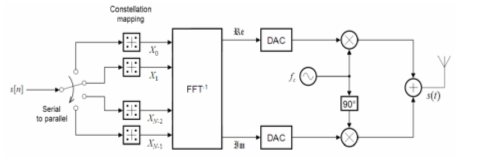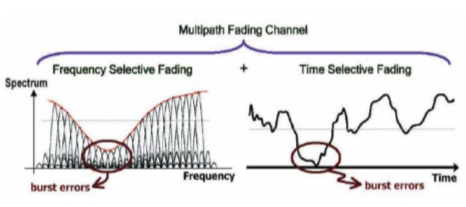This article presents the use OFDM signals in the physical layer WiMax network. Using OFDM signal with a large number of subcarriers allows WiMax systems to effectively serve users in a direct line of sight, as well as moving subscribers.
Keywords: wireless mobile networks, OFDM signal, QAM, FFT- discrete inverse fast Fourier transform
Fixed WiMAX networks are implementing Broadband Wireless Access technology (BWA) of standard IEEE 802.16–2004. The main purpose of these networks is — the provision of services to corporate and individual customers for high-speed and high-quality wireless data, voice and video over distances up to several tens of kilometers. The WiMAX network featuring the latest achievements of science and technology in the field of radio communications, telecommunications and computer networks.
IEEE 802.16 standard defines the use of:
– At the physical (radio) level OFDM broadband radio
with multiple subcarriers.
– Link layer protocol used by modern
plural (multiple) Access Time Divion Multiply Access
(TDMA) and Scalable OFDM Access (SOFDMA),
– On a network (transport) the level of WiMAX networks use IP data transmission protocol widely used in most modern data networks, including the Internet.
Application OFDM signal in the physical layer network WIMAX
Wideband radio signals (NLS) was developed in the middle of the last century and was originally used for military purposes in order to improve noise immunity and secrecy of communication. The most important advantage of the broadband system is a high data rate. At the same time the concept of spread spectrum (of broadband) is treated not only as the use of a radio signal with a wide frequency spectrum, but also as a system's ability to provide a high data transfer rate required for multi-service (Internet access, data, voice, video, etc.).
In WiMAX systems used broadband Orthogonal Frequency Division Multiplexing (OFDM) signal composed of a plurality of spaced frequency spectrum of narrowband signals. The use of OFDM signal provides WIMAX systems, the highest in the class BWA spectral efficiency (data rate at one Hertz frequency spectrum band), the ability to work outside the line of sight, the highest energy parameters of communication, providing a high range of communication, the ability to effectively service the mobile subscribers.
OFDM WiMAX system signal spectral efficiency
The spectral efficiency of the system is estimated the maximum possible data rate (the number of transmitted bits / s) of the system in one band of frequencies occupied by one Hertz. High spectral efficiency of WiMAX system is achieved by allocating transmission on parallel subchannels odnesuschih OFDM signal information.
OFDM is a plurality of narrow-band frequency diversity — subcarrier (pic.1). OFDM signal is generated as follows. Some high-speed pulse sequence originally divided into a plurality of parallel digital streams with pulses of longer duration (pic.2).

Fig. 1. The spectrum of the signal with a single carrier and OFDM signal

Fig. 2. Formation of the OFDM signal
Each newly formed pulse sequence is modulated in amplitude and phase QAM wanted signal (constellation mapping), bearing information on the transmitted data. The resulting set of modulated sequences of pulses with a frequency in the multiplexer combined set of orthogonal frequency division multiplexing (subcarriers) to form a single broadband signal. The signal converted to a plurality of subcarriers using a Digital Analog Converter (DAC) in a high-frequency analog signal and transmitted wirelessly. Operation orthogonal frequency division multiplexing from a mathematical point of view is the FFT operation is a discrete inverse fast Fourier transform. From a physical point of view, the time multiplexing translates the pulses in the time domain frequency distribution frequency domain (pic.3). On the receiving side the inverse operation takes place in the intermediate frequency conversion, demultiplexing and demodulating the wideband signal.

Fig. 3. Principle of the formation of spaced frequency subcarriers
The major difference from the simple OFDM technology division radio in several parallel frequency channels in the group is orthogonality subcarrier OFDM signal spectrum. The physical meaning of orthogonality is blended, the structure of each subcarrier special mark — a specific unique number of sinusoidal signal fluctuations, differing in phase by 90 ° (orthogonal functions), allowing the demultiplexer based on the analysis of the data labels to share subcarriers signals even in the case of a partial overlap of their frequency spectrums. Isolation of total carriers in a conventional multi-channel signal spectrum due to the limited processing capabilities of modern frequency bandpass filters requires a sufficiently large carrier frequency separation, which limits the increase in their number in a given frequency band.
Isolation of the spectrum in the group carrying the OFDM signal when demultiplexing is performed using orthogonal transformation signals. This allows the possibility of overlapping of the spectra of neighboring subcarriers, which can significantly increase the frequency of their placement density in the signal spectrum and increase spectral efficiency. First, this method was used to expand the spectrum DSSS techniques for forming interference and background noise of broadband noise-like signal is formed by multiplying (multiplexing) narrowband signal to a random sequence of high-speed pulses. This technology has been implemented in wireless local area networks, the first-generation Wireless LAN (WLAN) IEEE 802.11 standard, GPS satellite navigation systems. The method of allocating signals pledged their formation numeric codes also realized in mobile Code Division Multiply Access (CDMA) standard.
Application OFDM signal allows WiMAX networks provide higher data rate compared with single carrier systems, which is achieved by allocating transmission over a plurality of parallel frequency channels of information. Using OFDM, in principle, not a specific feature of the WiMAX technology. OFDM modulation is also used, for example, a Wi-Fi standard, IEEE 802.11 a / g systems. However, in OFDM standard IEEE 802.16 WiMAX technology is a much larger number of subcarriers, determining a higher spectral efficiency WiMAX systems compared to systems standard IEEE 802.11 a / g. OFDM signal in the WiMAX IEEE 802.16–2004 fixed network access standard has 256 subcarriers in networks IEEE 802.16e mobile WiMAX standard — up to 2048 subcarriers, and the standard IEEE 802.11a / g Wi-Fi systems — only 64 subcarriers. It should be noted that most systems BWA previous generation broadband wireless access (so called preWiMAX system) based on the IEEE 802.11a standard chipset. All modifications and improvements Wi-Fi systems, allowing them to be used for BWA purposes, are performed in software. Thereby, the signals preWiMAX, as well as Wi-Fi, have only 64 subcarriers. This means that a fixed WiMAX access network is approximately three times or more greater spectral efficiency as compared with Wi-Fi systems and preWIMAX. Thereby, the limit of the data rate on a physical layer of the network using the communication channel of the same width in WiMAX systems, more than three times higher than preWiMAX and Wi-Fi systems. Since the theoretical limit of the transmission channel WiMAX IEEE 802.16–2004 standard speed 10 MHz (128 subcarriers) is about 36 Mbps. Tensile data transmission system based on the IEEE 802.11a standard Atheros chipset used in Wi-Fi, and pre-WiMAX communication speed in the channel of 20 MHz (64 subcarriers) is approximately 30 Mbps, and accordingly, a communication channel 10 MHz (32 subcarriers) — less than 15 Mbps.
Suppression of the OFDM signal fading
Another key advantage of WiMAX technology, provides the use of the OFDM signal is the possibility of efficient operation of the communication channel in the absence of direct visibility Non Line Of Sight (NLOS) between the base station Base Station (BS) and subscriber terminal Subscriber Station (SS). Possibility WiMAX networks operate in NLOS conditions is due to the stability of the OFDM signal to a plurality of subcarriers to multipath propagation that takes place as a result of signal reflections from obstructions between the BS and SS. Multipath propagation results in the so-called fading («fading» fade), when the signal from obstacles re-reflection repeatedly comes to the receiving point with different amplitude, phase and time delay. Multipath signals add up in anti-phase, lead to a lower level (fading) of the resulting signal amplitude. To combat fading using different methods. Thus, in the Wi-Fi systems IEEE 802.11b standard (single carrier signal) using the method of diversity reception (antenna diversity), when the direct and reflected signals are received by two antennas spaced a half wavelength. In GSM and CDMA systems (single carrier) involves complex equalizers and filters. The most effective way to deal with fading is to use a plurality of OFDM signal subcarriers. Time delays of subcarrier pulses and their addition with different phases on the reception side reduces (fading) during some time of the amplitude of subcarriers (bust time fading), which as a result of orthogonal transformation transformed (pic.4) fade (burst frequency fading) of subcarriers in a band frequency spectrum (pic.5). Distortions subcarriers obtained as a result of the fading of this type are known as Inter-Symbol- Interference (ISI)

Fig. 4. Conversion temporary fading frequency signal in the OFDM receiver

Fig. 5. Frequency and timing signals fading
Efficient selection of multipath signals (echo cancellation) input with a certain time delay, it can be performed if there is sufficient guard time between the arrivals of pulse signals. The duration of this interval should not exceed the maximum (or average) time delay (delay spead) arrival of multipath signals. For the office environment in the local wireless network, a typical delay time of 20–200 ns, BWA systems in urban areas — 5–10 microseconds, 0.2 ms in the countryside. The major source of inter-symbol interference of OFDM signals are subcarrier frequency distortion from the signal transmitters of moving objects due to Doppler effect. This problem is solved by a method analogous to suppress fading by increasing the number of subcarriers to 1028. This makes it possible to efficiently serve motive objects, in mobile subscribers.
Thus, the use of OFDM signal with a large number of subcarriers, WiMAX systems allows users to serve effectively in the absence of line of sight, and moving (mobile) subscribers.







